Lionhead rabbits look like mini-versions of lions because of their famous manes. These unique bunnies are playful and energetic, attracting many rabbit owners. However, they can also be skittish when mishandled. Also, their long coats need special attention to keep them healthy. Do you want to keep a Lionhead rabbit? Keep reading to learn more!

Lionhead rabbit
Facts about Lionhead Rabbits
| Body Size | Small |
| Body Weight | 2.5 lbs to 3.75 lbs |
| Body Shape | Compact |
| Life Span | 7 to 10 years |
| Colors | Agouti, self, shaded, tan, marked, wideband |
| Rarity | Common |
| Similar Breeds | Swiss Fox Rabbit, Netherland Dwarf Rabbit |
| Best Suited For | Experienced rabbit owners, couples, singles, families with older children |
| Origin | France and Belgium |
Background and History
The Lionhead rabbits originated in Belgium. It was after breeders decided to create a toy breed. They crossbred the miniature Swiss Fox rabbit and the Netherland Dwarf rabbit. The result was a Lionhead rabbit. The mane located at the head and on the flanks of this breed came from a genetic mutation. A Lionhead may have a single or double mane depending on the parents.
Although Lionhead rabbits came from Belgium, their development transpired in the United Kingdom. In 1998, the British Rabbit Council (BRC) showed interest in the breed. In the following year, they accepted the standard of the breed. A club representing the Lionhead rabbits also appeared in the same year. However, it was in 2002 that the UK officially recognized the breed.
Joanne Staler of Minnesota brought the breed from England to the United States in 2000. Some breeders conducted hybridization. It led to the appearance of the Lionhead that we have today. It became famous as a companion animal and a breed for rabbit shows. On February 1, 2014, ARBA recognized the Lionhead rabbits as the 48th breed.
Features of Lionhead Rabbits
Body Size
Since the Lionhead rabbits are a toy breed, they can only grow up to 2.5 to 3.75 lbs. Their shoulder height measures 12.7 to 16.5 cm, while their body length is between 20.3 to 25.4 cm. Their head is oval with a long muzzle. Compared to does, bucks have a wider head. You will also notice their round and shiny eyes.
When judging Lionheads, 45 points go to the general type, while 40 points are to the fur. Its compact body must be well-rounded, while its chest and shoulder must be well-filled. The legs should be medium in length and medium in bone. A long and narrow body is considered faulty. The ears must be well-furred and carried in a slight “V.”
Coat

A double mane lionhead bunny
Lionhead rabbits look like mini-versions of lions because of their mane. They can have either a single or double mane, depending on their genes. At birth, you will already determine what kind of mane your Lionhead bunny has. A single man makes it looks like a typical bunny since the wool is thin. It is located around the bunny’s chin, ears, and head.
A double-maned Lionhead bunny makes it look more distinct. You will notice the mane forming V-shape around its loins, also referred to as skirts. The ideal length of the mane is about two inches, while its transition wool must be at least one length. Lionheads that have short or no mane are disqualified on rabbit shows.
In terms of coat colors, ARBA acknowledged only two varieties. They are the Tortoise and Ruby-eyed White (REW). However, there are other varieties available. Here are some of them:
| Categories | Colors |
| Agouti | Chestnut, squirrel, sable agouti, chinchilla, chocolate chinchilla, opal, chocolate chestnut/agouti, lynx |
| Self | Lilac tort, blue tort, black tort, chocolate tort, lilac, blue, chocolate, black, Blue-eyed White (BEW), Red-eyed White (REW) |
| Shaded | Pointed white, chocolate point, smoke pearl point, sable point, seal, smoke pearl, siamese sable |
| Tan | Fox (tortoise otter), chocolate otter, blue otter, black otter, smoke pearl marten, silver marten, sable marten |
| Marked | Harlequin, Vienna marked, broken/butterfly |
| Wideband | Fawn, orange, frosty (frosted pearl) |

A lionhead inside a basket
Temperament and Behavior
Because of their playful and energetic behavior, Lionhead rabbits are popular household pets. Their temperament is comparable to cats. Young Lionheads love to play with toys and hop around the house. They also get along with other household pets. However, you should be careful when introducing them to your cats and dogs.
As these bunnies grow old, they become less energetic. Adult Lionheads prefer to rest on their hutch or sit on their owners’ laps. But you should give them some time to go outdoors to exercise and socialize. As a reminder, these bunnies are highly social animals and crave attention. You may want to keep more than one Lionheads.
Even if Lionheads are friendly, they can become skittish when frightened or stressed. Some experts don’t recommend them for families with small children. When mishandled, these furry pets can scratch their owners. They are also intelligent bunnies. Keep them busy by giving them toys that stimulate their minds.
Grooming Lionhead Rabbits
Like other rabbit breeds, Lionhead rabbits need regular grooming to stay healthy. Since they have long and dense coats, brushing them is necessary. In the non-shedding season, brush their coats twice to thrice a week. However, you need to do this regularly if they are shedding.
As a warning, Lionheads are feisty when they are shedding their fur. It is because of their delicate skins. You only need to pick and hold them during the grooming sessions. These bunnies love to be groomed when they are molting. If you don’t know how to groom a rabbit, you can ask the vet for the proper procedures. It is also an opportunity to ask all you need to know about grooming.
When brushing a Lionhead, you must put it in your lap. Begin by brushing the tip of its fur and going to the roots to eliminate the knots. Never forcefully pull the bunny’s fur, and avoid touching its skin with the end of the brush. To get rid of the matting, you must brush your pet’s back and side. Occasional trimming is also necessary for Lionheads. Use scissors to trim the excessive fur, but do it with care.
Cutting the bunny’s nails is also vital. Your pet mustn’t be frightened since it can be injured while doing the trimming. You can put a light towel or cloth over its head to ease nerves. When trimming, you must prevent cutting the quick since it is the vein inside the nail. You can also provide digging and scratching areas on the bunny’s hutch to slow down the nails’ growth.
Proper Diet
Because of their sensitive digestive systems, a proper diet is vital to all bunnies. Similar to other rabbits, the daily intake of a Lionhead must be 70% to 80% hay, 10% pellets, 10% to 15% vegetables, and 5% fruits. Since grass is vital to its health, it must be available daily. There are lots of options that you can choose from: timothy hay, oat hay, and orchard grass are some of them.
Another essential food in your rabbit’s diet is vegetables. However, 80% of the vegetables must be leafy greens since they help the bunny’s digestion motility. Some vegetables you can give to a Lionhead rabbit are Brussels sprouts, kale, and parsley.
Pellets help keep the bunny healthy since they contain essential nutrients. However, it should only be 10% of your rabbit’s diet. Giving too many pellets may lead to obesity, resulting in other severe health issues. In choosing pellets, it must be high in fiber and low in calories.
Despite the nutrients that fruits contain, you must give them occasionally. Too much sugar may cause an imbalance in their digestive systems. You must also avoid feeding them fruit seeds since they may be toxic to the bunny.
Lastly, you should not forget to provide your bunny with unlimited clean water. If your bunny loves leafy greens, it may drink less water. But you don’t have to worry since these greens are also rich in water.

Bunnies eating pellets
Habitat
To keep a Lionhead rabbit, you must provide a comfortable and large hutch. The ideal size of a Liohead’s cage is 60 x 60 cm. It is enough for the bunny to stretch freely and hop around. When choosing the material of the cage, metal is better than wood since it is easier to clean.
Never purchase cages with a bottom grid since they may injure your bunny. Unlike dogs and cats, rabbits’ paws have no pads, so they are more prone to foot sores. Ensure that the cage has solid flooring. You may also use sawdust, straw, and hornbeam as bedding since they help dry the floor.
For the cage’s location, you must place it where your rabbit is not exposed to too much heat. Bunnies directly exposed to the sun’s heat may suffer from heatstroke. You also must keep them in an area where they can interact with you.

the royal lionhead rabbit
Health Issues of Lionhead Rabbits
Diarrhea
Diarrhea is a common problem for rabbits because of their sensitive digestive system. If ignored, it may lead to death. Some of its causes are improper diet, bacterial infection, or chronic diseases.
Here are the symptoms of diarrhea:
- Dirty bottom, leading to skin diseases
- Loss of appetite
- Lethargy
- Weight loss
- Watery stools containing mucus or blood
- Painful abdomen causing the rabbit to hunch or press the abdomen
A rabbit with diarrhea may suffer from dehydration, so it is vital to provide it with fluids. You can give it some water or make it drink through a dropper syringe. If the dehydration is severe, go to the vet so he can administer the fluid through injection or skin drip.
You must provide a high-fiber diet to prevent your bunny from diarrhea. You must do it gradually when introducing new food to the bunny’s diet. Keeping its cage and environment clean will prevent it from catching sicknesses.
Rabbit Eye Ulcer
Due to the playfulness of Lionhead rabbits, they are prone to rabbit eye ulcers. It is a condition wherein the bunny’s eyeballs are wounded. It can be caused by a fight, hay inside the bunny’s eyes, or accidents. Some symptoms are closed eyes, tearing, bloodshot appearance, or sensitivity to the light.
To treat the swelling, the vet may prescribe non-steroid anti-inflammatory drugs. He also may prescribe antibiotics to prevent infection. If the case is severe, the vet may conduct an eye surgery, removing the injured lens.
Frequently Asked Questions
Do Lionhead rabbits like to be held?
Rabbits should not be bathed since they may suffer injuries and stress. A frightened rabbit may move a lot, causing a fracture on its spine or limb. The chill may also lead to respiratory problems like pneumonia and hypothermia.
Can I bathe my Lionhead rabbit?
Rabbits should not be bathed since they may suffer injuries and stress. A frightened rabbit may move a lot, causing a fracture on its spine or limb. The chill may also lead to respiratory problems like pneumonia and hypothermia.
Conclusion
Lionhead rabbits have distinct appearances and outgoing personalities. But like other rabbit breeds, they need a lot of attention. Because of their long coats, these charming bunnies are prone to health issues. Aside from that, they can also be feisty, so they must have owners who can understand them.
Read More



